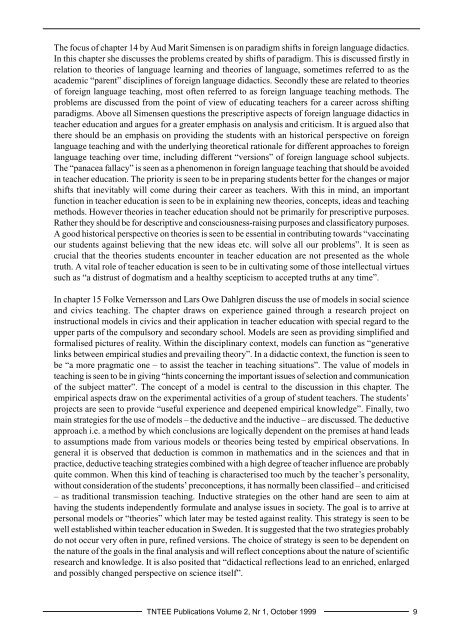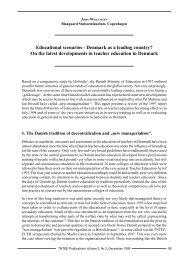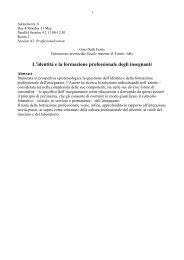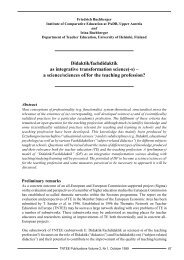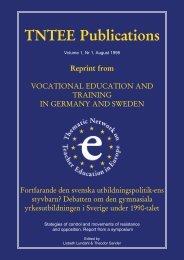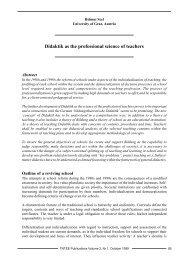TNTEE Publications - Didaktik/Fachdidaktik
TNTEE Publications - Didaktik/Fachdidaktik
TNTEE Publications - Didaktik/Fachdidaktik
Create successful ePaper yourself
Turn your PDF publications into a flip-book with our unique Google optimized e-Paper software.
The focus of chapter 14 by Aud Marit Simensen is on paradigm shifts in foreign language didactics.<br />
In this chapter she discusses the problems created by shifts of paradigm. This is discussed firstly in<br />
relation to theories of language learning and theories of language, sometimes referred to as the<br />
academic “parent” disciplines of foreign language didactics. Secondly these are related to theories<br />
of foreign language teaching, most often referred to as foreign language teaching methods. The<br />
problems are discussed from the point of view of educating teachers for a career across shifting<br />
paradigms. Above all Simensen questions the prescriptive aspects of foreign language didactics in<br />
teacher education and argues for a greater emphasis on analysis and criticism. It is argued also that<br />
there should be an emphasis on providing the students with an historical perspective on foreign<br />
language teaching and with the underlying theoretical rationale for different approaches to foreign<br />
language teaching over time, including different “versions” of foreign language school subjects.<br />
The “panacea fallacy” is seen as a phenomenon in foreign language teaching that should be avoided<br />
in teacher education. The priority is seen to be in preparing students better for the changes or major<br />
shifts that inevitably will come during their career as teachers. With this in mind, an important<br />
function in teacher education is seen to be in explaining new theories, concepts, ideas and teaching<br />
methods. However theories in teacher education should not be primarily for prescriptive purposes.<br />
Rather they should be for descriptive and consciousness-raising purposes and classificatory purposes.<br />
A good historical perspective on theories is seen to be essential in contributing towards “vaccinating<br />
our students against believing that the new ideas etc. will solve all our problems”. It is seen as<br />
crucial that the theories students encounter in teacher education are not presented as the whole<br />
truth. A vital role of teacher education is seen to be in cultivating some of those intellectual virtues<br />
such as “a distrust of dogmatism and a healthy scepticism to accepted truths at any time”.<br />
In chapter 15 Folke Vernersson and Lars Owe Dahlgren discuss the use of models in social science<br />
and civics teaching. The chapter draws on experience gained through a research project on<br />
instructional models in civics and their application in teacher education with special regard to the<br />
upper parts of the compulsory and secondary school. Models are seen as providing simplified and<br />
formalised pictures of reality. Within the disciplinary context, models can function as “generative<br />
links between empirical studies and prevailing theory”. In a didactic context, the function is seen to<br />
be “a more pragmatic one – to assist the teacher in teaching situations”. The value of models in<br />
teaching is seen to be in giving “hints concerning the important issues of selection and communication<br />
of the subject matter”. The concept of a model is central to the discussion in this chapter. The<br />
empirical aspects draw on the experimental activities of a group of student teachers. The students’<br />
projects are seen to provide “useful experience and deepened empirical knowledge”. Finally, two<br />
main strategies for the use of models – the deductive and the inductive – are discussed. The deductive<br />
approach i.e. a method by which conclusions are logically dependent on the premises at hand leads<br />
to assumptions made from various models or theories being tested by empirical observations. In<br />
general it is observed that deduction is common in mathematics and in the sciences and that in<br />
practice, deductive teaching strategies combined with a high degree of teacher influence are probably<br />
quite common. When this kind of teaching is characterised too much by the teacher’s personality,<br />
without consideration of the students’ preconceptions, it has normally been classified – and criticised<br />
– as traditional transmission teaching. Inductive strategies on the other hand are seen to aim at<br />
having the students independently formulate and analyse issues in society. The goal is to arrive at<br />
personal models or “theories” which later may be tested against reality. This strategy is seen to be<br />
well established within teacher education in Sweden. It is suggested that the two strategies probably<br />
do not occur very often in pure, refined versions. The choice of strategy is seen to be dependent on<br />
the nature of the goals in the final analysis and will reflect conceptions about the nature of scientific<br />
research and knowledge. It is also posited that “didactical reflections lead to an enriched, enlarged<br />
and possibly changed perspective on science itself”.<br />
<strong>TNTEE</strong> <strong>Publications</strong> Volume 2, Nr 1, October 1999 9


